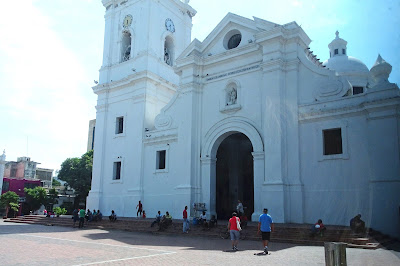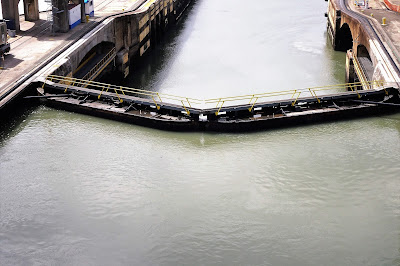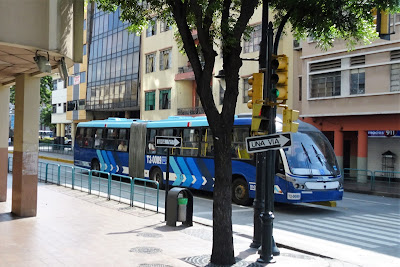Monday, April 23, 2018 – Oranjestad, Aruba
Due to its location, Aruba is outside the Caribbean hurricane belt. It has a dry and sunny climate year-round and an arid, cactus-filled landscape, especially on the northeast coast of the island. But the tropical heat is moderated by near-constant trade winds off the ocean. This climate lures visitors to the island, as there is reliably warm, sunny weather. Aruba is a small island (only 69 square miles) but has a big population of around 105,000 people.
Oranjestad is the capital and largest city in Aruba. It was named to honor the Dutch Royal Family, which is known as the House of Orange. From our perspective, after visiting here twice in the past, the city consists primarily of hundreds of local stores where tourists can buy souvenirs along with government buildings and a few casinos as well. Along the main street, you’ll normally find droves of tourists walking around and shopping. To the best of our memory, that’s about it in Oranjestad.
When Crystal Symphony cut through the reef surrounding Aruba and docked at Oranjestad at about noon today, we took photos in both directions from the fantail of the ship, recognized where we were, and decided to walk a little while, but not too far, ashore.
Wednesday & Thursday, April 25-26, 2018 – Gustavia, St. Barts
It was an early arrival Wednesday morning (Apr 25), about 7:00am. We’re anchored well outside the sheltered harbor of Gustavia, capital city of the island of Saint Barthélemy (abbreviated as St. Barts in English). From where we’re tendered, about all we can see from our balcony on the starboard side of the ship is this volcanic rock in the harbor. This is just a pretty scene; it’s not the main island of St. Barts.
We’ve visited St. Barts in the past and took a panoramic tour of the entire island on one of those trips. This not a big island. In fact, we’d call it a small island ─ only 9.7 sq. mi. in size, with a total population estimated at 7,200 full-time residents. Of that number, 2,300 live in the capital city of Gustavia, and the remainder live in small settlements scattered around the remainder of the island.
St. Barts was never one of the Caribbean’s sugar-producing islands; thus, they never developed an extensive slave trade. We’ve read that about 90% of the island’s inhabitants are still of European descent. The first French settlers arrived in 1648, and it remained in French hands until 1784, when France sold the island to Sweden, which renamed the largest town Gustavia, to honor their King. France repurchased the island and took back control in 1878. Architectural style is still influenced partially by the Swedish period.
These days, St. Barts is an “overseas collectivity” of France and is one of four territories in the northeastern Caribbean that comprise what’s called the French West Indies, along with Saint Martin, Guadeloupe, and Martinique. This means that they are French citizens and follow the same laws and regulations as the mainland of France. As well, they have a senator sitting in the French Senate. French is the native language of St. Barts, and the Euro is official currency. We learned about these “overseas collectivities” of France when we were in the South Pacific (New Caledonia and French Polynesia) last month on this world cruise.
The island’s terrain is volcanic and rocky, with steep hills and valleys, twisty roads, and somewhere around 15 beautiful, secluded sandy beaches. The weather is mostly sunny and dry year-round. Many people consider St. Barts to be the Caribbean's most beautiful island. Much of the pockets of population outside of Gustavia are clustered around small hotels or villas. From what we’ve read, there are only 25 hotels on the island, and most of these are boutique in style with 15 rooms or less. In addition, we were told there are hundreds of upscale villas for rent on the island.
The language, cuisine, and culture are definitely French, and their tourist offerings are oriented to the upscale end of the market. We read that they record about 200,000 visitors per year in St. Barts ─ luxury hotels and villas host 70,000 visitors each year with another 130,000 arriving by boat (including many of these by large, seagoing yachts).
Enough of the background, we decided that we didn’t need to sign up for a shore excursion either day we were in port. On Wednesday, we hopped on a tender boat at about 9:30 for the fairly lengthy trip to Gustavia, and Thursday we stayed on board ship. Departure from St. Barts was at 2:00pm Thursday afternoon.
Gustavia is a pedestrian-friendly town, wrapped around three sides of the horseshoe-shaped harbor. The tender pier is located right in the center of town. From there, we walked on Rue de la Republique, Rue de la France, and Rue du Bond du Mer (basically walking part way around the harbor), admiring red-roof bungalows dotting the hillsides, the upscale shops, and the equally upscale yachts docked in town.
Symphony stayed overnight anchored Wednesday evening at St. Barts, and the tender boats were running until midnight. That gave everyone a chance to sample the famous, elegant French cuisine on the island if they were interested. We decided that our ship’s cuisine was good enough for us. We were, however, a little jealous that Crystal took about 200 travel agents (who have been traveling with us this segment of the world cruise) out to a swanky dinner party last night in town. That was a decision that didn’t sit well with many of the world-cruisers, since we weren’t invited.
The good news is that St. Barts appears to have made a strong recovery from the damage it sustained from last summer’s Hurricanes Irma and Maria. We saw no aftereffects in Gustavia; but, of course, we didn’t travel out into the countryside to look around.
St. Barts’ small island size, and its rugged terrain, limited fresh water resources, and the necessity to import almost all food products, must all make it unsuitable for mass-market tourism. It’s definitely a beautiful island with a relaxed, slow-paced lifestyle, making it attractive for a limited number of high-end travelers or yacht owners who can afford the high cost-of-living. This was quite a contrast with what we saw on all the other 20 islands we’ve visited on this world cruise.
We now have two sea days before our next port of call in Key West, Florida – about 1,157 nautical miles (1,332 statute miles) away. Our route will take us north of Puerto Rico, Hispaniola (Dominican Republic/Haiti) and Cuba. We're nearing the end of the trip, so we have a lot of packing to do; we might not even get off the ship in Key West.
This likely will be the last posting we send out for this blog until we get home on April 30, do some unpacking, and catch up on anything of immediate importance at home. We will send out a posting to summarize the 2018 World Cruise, from our perspective, when we have a chance.
Jim & Ginny






















































